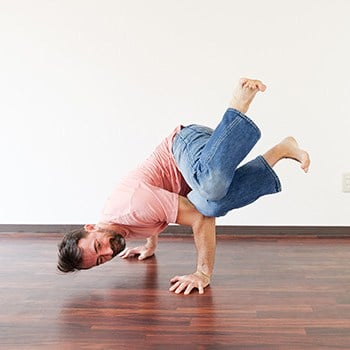Do you want to reduce the stiffness and soreness that you get from working out? Would you like to see results faster?
If so, we’ll show you how to do it properly using the concept of active recovery.
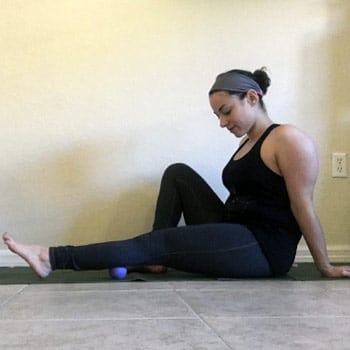 You probably know recovery is important. But did you know that what you do (or don’t) in between your workouts can actively speed up your recovery and progress?
You probably know recovery is important. But did you know that what you do (or don’t) in between your workouts can actively speed up your recovery and progress?
For starters, recovery isn’t just ‘taking time off’ and not doing anything whatsoever until it’s time to train again.
But ‘active recovery’ doesn’t mean you’re doing a full-blown workout, either.
There are times to push yourself and times to dial it back.
Contrary to what some might suggest, being completely sedentary is not always the best option because light movement can speed up your recovery when you’re actively working toward that perfect handstand.
Proper rest and recovery is at least half, and maybe even more, of the health and fitness equation.
🤔 Part of recovering well is getting your body moving regularly. Download our free 15-Minute Mobility Boost and be sure you’re taking care of your body daily.
While intense training is beneficial and necessary for many goals, part of that training includes breaking the body down. You need to balance that out by allowing it to build itself back up. And that’s where proper recovery techniques are essential.
When you prioritize recovery, you’ll have a much easier time reaching your goals.
In this article, we’ll talk about the importance of active recovery, take you through some important strategies, and address some common questions and concerns.
Here’s our podcast on recovery:
Do You Really Need to Spend Time on Recovery?
For people who train intensely and regularly, the idea of taking a break and allowing the body to recover can sometimes feel like a cop-out.
After all, so much of our capacity for training is really mental, rather than physical. For most of us, mental fatigue is far more of an issue, and if we isolate the physical aspect, our bodies can probably handle a lot more than we think.
But, of course, there are a couple of issues with this.
- For one thing, isolating the physical aspects from the mental is impossible. The connection between the mind and the body is very real, and trying to emphasize one to the detriment of the other will only lead to trouble in both arenas.
- It’s common to overdo things and burn yourself out before you even realize that’s happening. This is where autoregulation comes in handy, as it will help you pinpoint when you’re pushing yourself too hard.
Whether or not you are acutely aware of your body’s (and mind’s) need for recovery, it’s an essential part of keeping yourself healthy, while continuing to close in on your goals.
This is why most all sane and reasonable fitness programs are designed in a way to allow the body to recover via built-in rest days, or a combination of intense sessions and very light sessions.
Anyone telling you to train hard and never take days off doesn’t live in the real world, have regular obligations, or life stressors.
If you don’t give yourself the time you need for adequate recovery, you risk injuries and other setbacks due to fatigue and burnout.
Our Recommended Recovery Exercises
You can see we like to focus on active recovery using full-body movement rather than relying on a lot of gadgets and external tools.
There’s nothing wrong with ice baths, but it’s a lot easier just to get down on the floor and do some gentle movements 🙂
The Difference Between Active and Passive Recovery
To be incredibly clear, active recovery is defined as low-intensity activity that preps your body for another hard training session.
The act of moving regularly increases circulation, improves digestion, enhances mobility, and allows for your body to better utilize the food and nutrients from your diet to repair the body.
Because think about it… your 60-minute training session may have been difficult, but sitting around (and sleeping) for the next 23 hours isn’t going to do you much good because lack of movement will make you stiff.
Some examples of active recovery are:
- Focused stretching routines planned into your day
- Light activity that encourages blood flow and slightly elevated heart rate (think walking, biking, or flow work)
- Being active for the sake of it as opposed to sitting around all day (running errands, going for walks, playing on the floor with your kids)
Here’s an example of Jarlo doing some light movement outside to get the blood flowing:
View this post on Instagram
Passive recovery is where you’re completely at rest, doing nothing in particular. Passive recovery is necessary if you have a severe injury, you’re overstressed (mentally and physically), or if you’re under-slept and need the extra rest.
In general, being active is better overall, even if the activity you do in between your primary workouts are for leisure and relaxation. But don’t neglect taking some time to rest if you’re worn out.

How to Speed Up Recovery Between Workouts
Recovery has become something of a hot topic in the functional fitness community, which is good, of course. But there are some recommendations that are a bit complicated. You don’t need fancy gadgets or special supplements for recovery.
However, we will cover some of these gadgets and how they’re useful in a bit. Because we’ve played with a lot of them, and some are pretty cool.
Here are four simple strategies you can start using immediately.
1. Active Recovery Methods for Reduced Muscle Fatigue After Exercise
You already know that doing something is often better than nothing, unless passive rest is absolutely warranted.
Sitting around on the couch is one method of recovering, but when the body is stressed after a hard training session, it tends to get stiff. You will recover better if you find a way to keep moving.
This is very similar to what we recommend people do after an injury. You must find a way to move to increase your mobility and coax the healing along.
After all, more blood flow and more movement, in general, is better than none, even if it’s something light and easy.
Simple movements like we show in our relaxation routine can do wonders:
If, like many people in the Western world, you spend most of your time sitting, it’s especially important to keep your body moving on your rest days. This will help you recover much more quickly and effectively.
2. Get Enough Food and Sleep for Exercise Recovery
 The specifics of diet and nutrition, and even sleep hygiene, can be pretty involved. But as with anything, focusing on the basics will go a long way.
The specifics of diet and nutrition, and even sleep hygiene, can be pretty involved. But as with anything, focusing on the basics will go a long way.
Food is fuel, so you want to make sure that, as much as possible, you’re filling your body with good quality fuel (nutrient-dense foods, avoiding too much in the way of processed, empty calorie foods).
You have to know your own circumstances, but for many “hardcore” trainees, it’s important to make sure you’re getting enough food to fuel your activities. If you do three or four intense training sessions per week, you’ll need more fuel than someone who does one or two intense sessions per week.
We don’t like to make nutrition complicated, so we created a course called Eating Skills to help you make nutrition work for you without any of the gimmicks.
Sleep is certainly less complicated than diet, especially because the vast majority of people simply don’t get enough sleep. If you work on getting even one more hour of sleep than you do now, you’ll be doing great.
We basically have a built-in reset button that helps us recover and repair our bodies every night. If you’re not taking advantage of this and getting enough good, quality sleep, you’re really missing out. And it will catch up with you eventually.
3. Be Realistic and Consistent
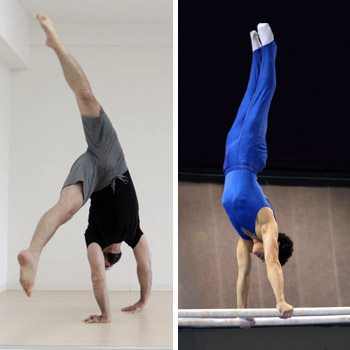 Consistent effort is the most important thing that will determine whether you reach the training milestones you want, or you’re left sitting on the sidelines.
Consistent effort is the most important thing that will determine whether you reach the training milestones you want, or you’re left sitting on the sidelines.
The disconnect for most people is how to be consistent.
Of course, prioritizing recovery is one of the key parts of staying consistent for the long haul, as injuries and burnout are common monkey wrenches for consistent practice.
Another key, though, is having a healthy dose of realism.
It’s all too common to have expectations of yourself that don’t really match up with the realities of what your body (or your mind) can handle, whether that’s on a particular day or over the course of a program.
Doing a realistic amount of work aids your body’s natural recovery process. Progressive overload done right also strengthens your recovery ability and you’ll be able to handle more work in the long run.
But if you push beyond your current capacities too often, you’ll quickly discover that it’s not the best idea for sustained growth and improvement.
Our bodies are great at adapting to stress–it’s a simple formula for self-improvement. However:
- Too much stress, and we’ll break ourselves down.
- Not enough stress, and we won’t improve.
We want just the right amount of stress. Then we grow and benefit from the experience. And, equally importantly, we’ll be able to stay consistent with our efforts this way.
4. Active Recovery Requires Mindful Reflection
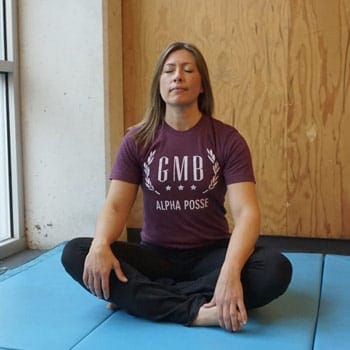 Don’t worry, I’m not going to tell you to start sitting on a mountaintop in solitude.
Don’t worry, I’m not going to tell you to start sitting on a mountaintop in solitude.
Mindful reflection may sound kind of “woo-woo” but really, it’s just about being more present and mindful in your life (including in your training). This is an important part of our training methodology for a reason.
It’s also why we are so adamant about you following a plan that is structured and organized. When you have a plan that is laid out, you can focus. But when you try to wing it, it’s hard to be mindful of what you’re doing and it’s easy to get distracted.
Prioritizing mindfulness will help you get as much benefit as possible from the training you do, and will help you recover better in between your training sessions.
In this article, you’ll learn a lot more about how to bring mindfulness into your training, but on your recovery days, we also highly recommend practicing some form of meditation.
Here’s a really short and simple breathing meditation I like to use to aid in my recovery process. This simple technique may be both the easiest and most advanced mental training practice you’ll learn. I combine it with this evening stretch routine to wind down and get better quality sleep.
- Get into a comfortable position, either sitting or lying down, and stay with it for a while before switching around–close your eyes and just observe your breath.
- Some teachers have you count, while others ask you to regulate the breath in some way. I’ve found it’s best just to “watch” your breath and concentrate not on controlling the inhale and exhale but simply to observe it.
- Set a timer and start at 5 minutes, adding a minute every day or so until you reach a max of 15 minutes.
- It will be difficult at first, just like everything that’s worthwhile, but keep at it. Don’t do anything but concentrate on how you are breathing. Don’t force it and soon you’ll find that you’ll be “losing” yourself and the timer will ding before you know it.
- The key, and I cannot stress this enough, is to not strain. You can’t force yourself to relax! Keep at it everyday but if in a session you find yourself working too hard to concentrate, it’s best to bag it and try again later.
You can also use an app like Headspace or Calm to aid you in this. Or, if breathing doesn’t do it for you, try bringing mindful awareness to another activity. Even something simple like washing the dishes can be a meditative activity if you approach it the right way.
In our programs, we ask you to ponder and think about what you’ve just accomplished. When you reflect on how your session went, it helps you learn more about your progress and how you’re doing. This way, you become more in tune with your body over time.
FAQs About Fitness and Muscle Fatigue Recovery
Most of us don’t spend nearly enough time on recovery, but if you’re trying to make it a priority, you might have some questions. We get many questions and concerns from our clients and readers on this topic, so I thought I’d address the most common ones below:
My muscles are really sore and fatigued after working out yesterday. Is that bad? What should I do?
Muscle soreness is very normal, especially if you’re just starting a new program or working on some new exercises. It’s nothing to be concerned about.
With that said, there is a big difference between soreness in the muscles (which is totally fine), and pain in the joints (which is not). If you’re experiencing the latter after a workout session and the pain persists, you should go see a medical professional to see what’s going on.
As for how to handle muscle soreness, the best thing you can do is keep moving and stretching.
I know that’s uncomfortable when your muscles are really sore, but the increased blood flow will help you work through that soreness much more quickly.
My muscles didn't get sore after my last workout. Does that mean it didn't work?
This is a really common misconception. While muscle soreness is a normal occurrence, it’s not a necessary process for getting benefit from your training program.
In fact, the only way to ensure you’re always feeling sore after a workout is to keep changing your training program. I know I’m going to sound like a broken record, but consistent practice is the only way to make lasting progress. If you keep changing your training program, you will never get the consistent practice you need to reach your goals.
Muscle soreness usually only lasts for the first week or so of a new program. When the soreness fades, that’s when the real benefits of consistent practice begin, so keep at it.
Should I be taking any specific supplements for recovery?
There is some research on certain supplements for certain aspects of recovery (Examine.com is a great resource for that), but truthfully, if you’re focusing on the other recovery strategies above, you’ll be fine without any fancy supplements.
And that’s especially true if you’re making sure you’re getting enough food, and particularly enough protein to keep your muscles supported.
What do you think about taking epsom salt baths?
Who doesn’t love a good soak in the tub?
While there’s no great evidence that magnesium (that’s what epsom salts are made of) is absorbed through the skin, there’s certainly no harm in adding some to a hot bath whether or not your muscles are feeling sore.
What do you think about cold showers?
They’re freezing! Cold showers have grown in popularity the last few years. For some it’s a badge of honor to have the discipline required for a daily cold shower.
For others, they use it as a recovery tool. Cold showers have been used to help reduce DOMS (delayed onset muscle soreness) post-workout. And cold water immersion has been shown to reduce inflammation post exercise, which can allow for more regular training. But be mindful that cold water plunging can be dangerous for some people with heart conditions. So talk to your doctor before taking the plunge.
Enhancing Recovery with Gadgets and Tools
You’re probably aware there are a ton of recovery tools on the market. Things like simple massage sticks and lacrosse balls that cost a few bucks, all the way up to $400 massage guns.
Then you have health trackers like the Oura ring, Whoop strap, FitBit, Apple watch, and basic step counters.
By the way, we’ve used a lot of these gadgets. Here’s just a sample of what’s out there:
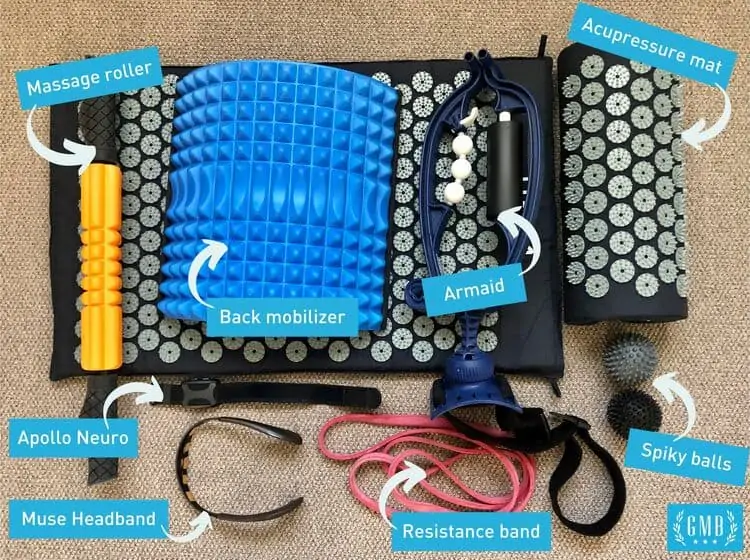
In this image above, we have the following:
- Acupressure mat – This mat is full of tiny little spikes that looks a bit odd at first glance. The idea here is to lay down on these mats for 15-20 minutes for relaxation. There isn’t a ton of research behind these, but scientists think the mat may trigger the parasympathetic nervous system, allowing a person to relax more fully than just lounging around. Lots of people swear by them, so there’s that.
- Massage roller – These are really common among runners and athletes. The stick allows you to massage muscle groups much easier than just using your hands… and the idea here is to relieve tension after a hard workout or on the days you practice your active recovery. And massage generally increases the blood flow, which is always good for recovery.
- Resistance band – You’ve probably seen these in the gym. They’re great for assisting certain stretches, and you can use them to add resistance when practicing PNF stretching, where you mix short periods of contractions followed by periods of lengthening your muscles (stretching).
- The Armaid – This is a massage tool that helps relieve annoying issues like tendinitis, golfers elbow, and other pain that often comes from overuse or repetitive strain injuries.
- Apollo Neuro Band – This band can be worn on your wrist or ankle, and sends light, inaudible sound waves through your skin, stimulating your nervous system to help relieve stress and help you relax.
- Muse Headband – People use this headband to get into deep meditative states, enhancing their ability to remain calm and relaxed, and it also helps with getting more restful sleep.
- Spiky massage balls – Similar to lacrosse balls, but the spikes give a different sensation. They’re mostly used for self-massage, myofascial release, and help relieve tension in tight muscles.
What’s not pictured that we have experience with is the Oura Ring, and Whoop Strap, both of which help people manage their sleep, and strain from exercise. We also have experience with massage guns. 🔫
But do these things actually improve your recovery on their own, or are they only helpful?
Well, the answer is a bit of both, but most of the onus is on you, what you do with them, and how you approach recovery as a whole
For example, we know sleep is the one chance we get every single day to allow our bodies to recover properly. Sleep is the most restorative thing you can do that requires no effort on your part, other than getting into a good sleep routine.
The question is, are you getting to bed early enough to get an adequate amount of sleep? If not, no amount of effort using recovery devices is going to help much.
But there are some tools that offer feedback in realtime, and those can help you make decisions about your training.
Wearables that Aid in Recovery
The Oura ring and Whoop strap both work similarly in that they help you manage and measure your HRV (heart rate variability).
In short, HRV is a measure of the variation in time between each heartbeat. HRV is largely controlled by your autonomic nervous system (ANS), which is the system that regulates your respiration, digestion, heartbeat, and blood pressure. The ANS is split between your sympathetic nervous system, and parasympathetic nervous system.
Parasympathetic refers to the relaxation response, which is what kicks in at night when you’re winding down for bed. And the sympathetic system is your fight or flight response, like when you get bad news at work about a harsh deadline and the anxiety sets in.
HRV will vary from person to person, so you can’t really compare yours to someone else’s. An advanced athlete’s HRV will differ a lot from the weekend runner because of their individual training adaptations. Age is a factor too.
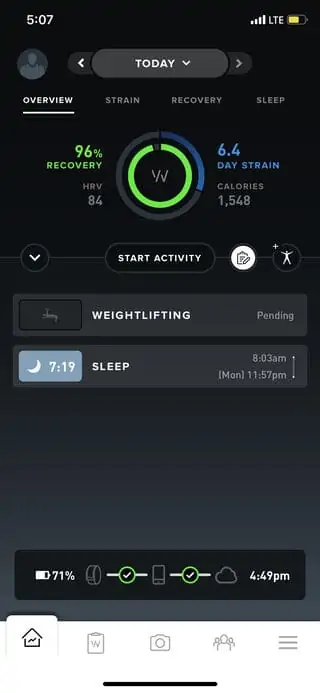 Tools like the Whoop strap will give you a daily recovery score based on your HRV as measured throughout the day. Typically, the lower your HRV score, the less recovered you are, and vice versa. And this can be used to help you make training decisions based on how recovered you are.
Tools like the Whoop strap will give you a daily recovery score based on your HRV as measured throughout the day. Typically, the lower your HRV score, the less recovered you are, and vice versa. And this can be used to help you make training decisions based on how recovered you are.
For example, if you trained hard yesterday and didn’t sleep well, your HRV may be low the next morning, indicating inadequate recovery.
So, you might opt for some lighter training or active recovery techniques instead of a strenuous workout. And on the days your HRV score is higher, you’re better recovered, so you can push yourself harder.
💡 Important Note: Measuring HRV is not an exact science, and some of these tools are prone to be inaccurate for some people. So don’t put everything into the data it’s giving you. Try to be mindful of how you feel, especially if your device says you’re ready for training, but you’re just not up for it.
A Gadget Isn’t Always Better than Your Subjective Experience
Sometimes we can rely too much on these devices and ignore subjective experience. Humans are complex animals, and our psychological experience can impact our ability to recover. We can even ‘think’ ourselves into certain states of being, such as being stressed and anxious, or happy and euphoric.
One case study out of Chicago details a woman’s experience with her FitBit tracker suggesting she wasn’t getting enough restful sleep [1]. So, she went into a clinic for a sleep study to see what was going on. After running the test, the doctors confirmed she was sleeping fine, all based on her brain waves, heart rate, and other physiological markers. But she didn’t want to believe it because of her obsession with the sleep data her FitBit was giving her.
Another paper tells us that in some cases, subjective experience trumps objective data and hard numbers. Sport scientist Anna Saw and other researchers reviewed some studies that were designed to assess training load and response, measuring hormone levels, inflammation post-workout, heart rates, and more [2].
Once they analyzed the papers, they realized that when comparing objective data to subjective experience by the athletes, the subjective reports were actually better at indicating levels of recovery and readiness than the hard science.
👉 As you go through our programs, we have you rate the quality of your performance by answering a simple question about how you felt about your performance (was it a tough effort? Or were you snappy with your movement?).
This way, you are encouraged to think about how you performed. And the introspection can help change your mindset to focus on quality movement, rather than quantity and grinding through exercises when it doesn’t make sense. This will improve your recovery over time because you learn how to autoregulate your training.
Massagers, Foam Rollers, Lacrosse Balls
Self massagers like massage guns, massage sticks, lacrosse balls, and foam rollers are popular among athletes, CrossFitters, runners, and many others who are training regularly. Lots of people use them because they work and it’s much cheaper and easier than getting a full body massage every week.
Massage helps your muscles relax and encourages blood flow to the affected areas, both of which will help speed up recovery.
Plus, you can use these gadgets as much or as little as you need, depending on what areas need the most work. For example, if you have tight shoulders, you can spend a little time every day digging into them with a lacrosse ball and stretching for 15 minutes instead of scheduling a massage. It’s both inexpensive and convenient.
What about myofascial release and does it work?
In short, yes. It works. You can use foam rollers, lacrosse balls, or your own hands to get it done.
Jarlo talks all about it here:
Embracing Active Recovery: Feel Better and Recover Faster
All the tools we covered, while great, are not necessary for most people. They can be incredibly helpful when used as a way to enhance recovery. But if you don’t have them, it’s not the end of the world.
In fact, we recommend you spend time on the following each day:
- Self-massage and myofascial release techniques to relieve tension in tight muscles.
- Mobility and flexibility training to keep you limber and moving fluidly.
- Breathing practice that allows you to relax your body and bring some calm into your life.
We created a recovery program called Regulator and it covers all 3 of these areas. You can enhance your recovery in as little as 15 minutes per day.
All you gotta do is show up.
If you’re serious about your training, you owe it to yourself to be serious about your recovery too. It’s not enough to only focus on the workouts. What you do in between will determine how quickly and efficiently you make progress.
Plus, these techniques will help you steer clear of injury.
Recover Faster Between Workouts
Regulator will help you make more progress with fewer setbacks from any GMB Program or other physical activity.

